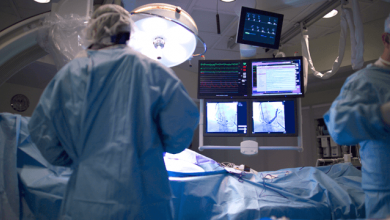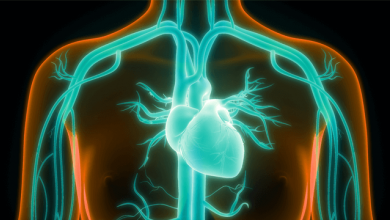Search results
Author(s):
Dario DiFrancesco
Added:
3 years ago
HCN4 (hyperpolarisation-activated, cyclic nucleotide gated 4) channels, the pore-forming α–subunits of ‘funny’ channels originally described in pacemaker cells of the sinoatrial node (SAN),1 are responsible for the early phase of diastolic depolarisation in these cells and are key determinants of pacemaker generation and control of heart rate.2–5 HCN4 channels are selectively expressed in the SAN…
View more
Author(s):
Mahmoud Abdelnabi
,
Ashraf Ahmed
,
Abdallah Almaghraby
,
et al
Added:
3 years ago
Ivabradine is a pure heart rate-lowering agent best characterised by its negative chronotropic effect on the sinoatrial node.1 Its unique mechanism selectively blocks the pacemaker funny (If) channels, which are responsible for spontaneous depolarisation in the sinoatrial node that regulates heart rate during sinus rhythm (Figure 1).2 Since 1980, it has been well established that controlling the…
View more
Author(s):
Moinuddin Choudhury
,
Mark R Boyett
,
Gwilym M Morris
Added:
3 years ago
The sinoatrial or sinus node (SAN) is the heart’s natural pacemaker. Located in the superior right atrium, it automatically produces cyclical electrical activity to initiate each heartbeat in normal sinus rhythm. SAN dysfunction (SND) in humans, also known as ‘sick sinus syndrome’, can manifest as pathological bradycardia and asystolic pauses. As a result, SND can lead to symptoms of reduced…
View more
Author(s):
Sharon A George
,
N Rokhaya Faye
,
Alejandro Murillo-Berlioz
,
et al
Added:
3 years ago
More than 100years have passed since the atrioventricular node (AVN) was first discovered by Sunao Tawara1 and described as a “Knoten” of tissue located at the proximal end of the Bundle of His (BoH).2 Despite the numerous advances in knowledge regarding the structure and function of the AVN, there are still several controversies that need to be addressed in both clinical and scientific settings…
View more
Author(s):
Sebastian Clauss
,
Moritz F Sinner
,
Stefan Kääb
,
et al
Added:
3 years ago
Atrial fibrillation (AF) is the most common arrhythmia experienced in clinical practice, and is responsible for significant morbidity and mortality.1 It affects more than 6 million people in Europe.1 The lifetime risk of developing AF after the age of 40 is approximately 25 %.1 AF is a major public health burden as it is associated with an increased risk of stroke by fivefold, dementia by twofold…
View more
Author(s):
Justin Hayase
,
Duc H Do
,
Noel G Boyle
Added:
3 years ago
The ICD is an important therapy for both primary and secondary prevention of sudden cardiac death in selected patients. The role for defibrillation threshold (DFT) testing either intraoperatively or postoperatively has changed significantly over the past few decades, and it is no longer routinely recommended in patients undergoing left-sided transvenous ICD implantation.1–7 The definition of the…
View more
Author(s):
Saad Fyyaz
,
Michael Papadakis
Added:
1 year ago
Author(s):
Adryan A Perez
,
Frank W Woo
,
Darren C Tsang
,
et al
Added:
3 years ago
The use of cardiovascular implantable electronic devices (CIEDs) has increased dramatically, with approximately 1.2–1.4 million CIEDs implanted annually worldwide.1 In the US alone, there are more patients with CIEDs than registered nurses.2,3 CIEDs use leads that connect a generator to cardiac tissue to treat patients with many conditions including symptomatic bradycardia, morbid tachycardia…
View more
Author(s):
Demosthenes G Katritsis
,
Bernard J Gersh
,
A John Camm
Added:
3 years ago
Thrombotic material in atrial fibrillation(AF) usually develops in the left atrial appendage as a result of decreased flow and stasis, possible endothelial dysfunction and a hypercoagulable state as indicated by increased fibrinogen, D-dimer, thromboglobulin and platelet factor 4 levels.1 In the Framingham Heart Study, the percentage of strokes attributable to AF increases steeply from 1.5 % in…
View more
Author(s):
Shohreh Honarbakhsh
,
Rui Providencia
,
Pier D Lambiase
Added:
3 years ago
Brugada syndrome (BrS) remains one of the most common inherited channelopathies associated with an increased risk of sudden cardiac death (SCD), with a worldwide prevalence of approximately 0.05%.1–3 It is accepted that appropriate utilisation of the ICD in high-risk patients with aborted SCD and haemodynamically compromising arrhythmias is life-saving. However, there remains a lack of consensus…
View more














